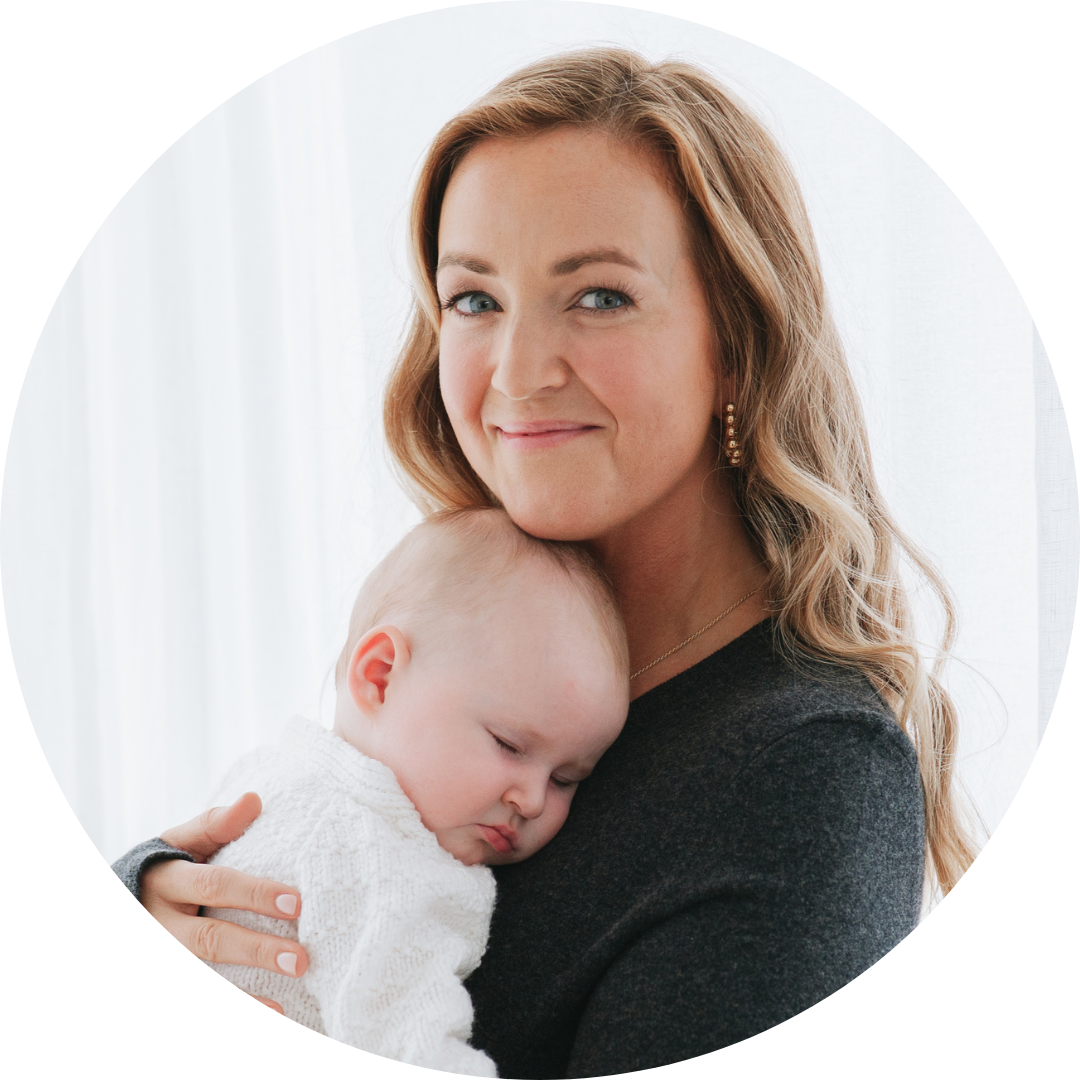Perhaps your baby has started self-settling at the beginning of a nap or bedtime but can't seem to do it during their sleep when they wake. Or maybe they are going down ok using something like rocking or feeding to sleep but this doesn't seem to be working well for re-settling in the early hours. Read on for my top tips on teaching babies to connect their sleep cycles.
Understanding sleep cycles in babies
Before diving into how to help your baby connect their sleep cycles, it's important to understand what these cycles actually are. Both adults and babies go through sleep cycles when we sleep. These cycles involve moving from deep sleep (non-REM sleep) into light sleep (REM sleep), and this happens multiple times throughout the night.
The average sleep cycle for a baby during the day is 45 minutes, with longer cycles at night. Between each sleep cycle, all of us partially wake - this is completely normal. As adults, we usually barely remember these brief wake-ups because we're so good at returning quickly to sleep. However, babies who haven't learned to self-settle often struggle with these natural wake-ups and require help to fall back asleep.
Is self-settling important?
In a word, yes. It is one of the most important factors in your baby being able to sleep for any long stretch without you needing to intervene. Beyond the first few weeks, helping your baby learn to self-settle is often key to achieving good sleep, particularly after 4 months when our babies' sleep matures and changes which can present as a regression.
When babies haven't learned to fall asleep independently, they struggle to connect their sleep cycles together during the night to make a longer stretch of sleep. This is also why some babies can only nap for a maximum of 45 minutes at a time - they're unable to connect their sleep cycles independently during the day either.
Pro Tip: For comprehensive guidance on teaching self-settling, check out our sleep guides here which include clear instructions for helping your baby learn this crucial skill.
Why babies settle well in the first part of the night but not the second
Many parents notice their baby can settle well at bedtime and in the early part of the night, but struggles with re-settling from around 1am onwards. There's a scientific reason for this pattern.
The first part of the night is when we have the sleepy hormone, melatonin, is on our side. Your baby's body is flooded with this hormone in the evening, and they've also built up "sleep pressure" from being awake during the day. Both of these factors combine to make the first stretch of the night (typically between 7pm-1am) the easiest time for babies to settle and stay asleep.
After approximately 1am, melatonin levels start to reduce and the "wake-up" hormone, cortisol, begins to rise as we approach morning. This means your baby's sleep becomes lighter and more fragmented. If your baby hasn't learned to settle themselves back to sleep, this is when you're likely to experience more frequent wake-ups.
This pattern is especially common around 3-4am, when sleep becomes the lightest. Many parents find this is one of the most challenging times for re-settling, which makes perfect sense from a biological perspective.
The going back to sleep challenge
If your baby has mastered falling asleep by themselves but hasn't got the falling back to sleep bit nailed yet, don't worry - this is incredibly common. The skill of falling asleep initially and the skill of falling back to sleep are related but separate abilities that babies need to develop.
If you used a settling method to help your baby learn to fall asleep independently and it worked, that's fantastic news! The next step is to apply that same method consistently for night wake-ups. Consistency is key here - using the same approach at bedtime and during night wakes and for those longer lunchtime naps which help your baby understand what's expected of them.
Pro Tip: Our extending naps guide provides detailed strategies for helping babies connect sleep cycles during daytime naps, which often translates to better night sleep too.
Choosing the right settling method
There are various settling methods you can use to help your baby learn to connect their sleep cycles. The two main approaches we recommend are:
Controlled comforting
This method involves staying in the room with your baby, providing comfort through gentle touching (such as tummy or head strokes) and quiet "shhing" sounds. You remain beside the crib to reassure your baby that they're safe while encouraging them to fall asleep in their own space.
This approach works particularly well with younger babies (from around 6 weeks) who benefit from your close presence while learning this new skill. The key is to gradually reduce your input as your baby becomes more comfortable settling independently.
Gentle controlled crying
This method involves putting your baby down awake and then leaving the room, returning at short, regular intervals (typically 1-2 minutes) to provide brief reassurance. During these check-ins, you offer comfort with a quick "shh" and perhaps a gentle hand on their chest for a few seconds before leaving again.
This approach can work better for older babies (from around 4 months) who might find your continuous presence overstimulating. Some babies actually settle better with a bit more space to figure out how to fall asleep on their own.
When to feed versus when to settle
One of the biggest challenges for parents is knowing when to offer a feed and when to use a settling method instead. This is particularly relevant if you're still doing night feeds or aren't ready to night wean completely.
The key is understanding your baby's feeding patterns and capabilities. Start by tracking your baby's feeds for a few days using a sleep diary or app. Look for your baby's "personal best" - what's the longest stretch they've gone between feeds at night?
Use this information as a benchmark. For example, if your baby has regularly done 4+ hours between feeds at night, you could use 4 hours as your guideline. If your baby then wakes 1-2 hours after their last feed, you know logically this is unlikely to be hunger and can attempt to settle them using your chosen method rather than defaulting straight to a feed.
Here's a practical framework for deciding:
• If less than your baby's typical stretch between feeds: try settling first
• If crying continues despite settling attempts: it's likely hunger
• If around their usual feeding interval: you can still try a brief settling attempt before feeding.
Remember, if your baby is genuinely hungry, they won't settle back to sleep with comfort alone - they'll make it very clear that food is what they need!
Environmental factors that support sleep cycle connection
Creating the optimal sleep environment can significantly help your baby connect their sleep cycles. Consider these important factors:
Darkness
The darker the room, the better. Light can be particularly disruptive during those lighter sleep phases in the early morning hours. Blackout blinds or curtains are essential, and even small amounts of light from digital clocks or night lights can interfere with sleep.
Temperature
Maintaining a room temperature between 16-20°C (61-68°F) helps prevent your baby from waking due to being too hot or cold. Use appropriate clothing layers and consider the tog rating of your baby's sleeping bag.
White noise
Consistent background noise can help mask household sounds that might disturb your baby during light sleep phases. If you use white noise, ensure it plays continuously throughout the night rather than turning off automatically.
Pro Tip: Check out our ‘Optimising your baby’s sleep environment’ blog for a comprehensive guide to the perfect sleep environment.
The importance of daytime naps
Many parents focus solely on night sleep, but daytime naps play a crucial role in helping babies learn to connect sleep cycles. A well-rested baby during the day is much more likely to sleep well at night.
Work on helping your baby connect sleep cycles during their longest nap of the day (typically the midday nap). If they wake after 45 minutes, give them the opportunity to self-settle back to sleep before intervening. This practice during the day often translates to better sleep cycle connection at night.
Common mistakes that prevent sleep cycle connection
Intervening too quickly
Many parents rush to their baby at the first sound, not realizing their baby might be in a light sleep phase and could settle back down with a few minutes of space. Unless your baby is actively crying, try waiting a few minutes to see if they return to sleep naturally.
Inconsistent approaches
Using different settling methods or constantly changing your approach confuses your baby and prevents them from learning what's expected. Stick with one method for at least a week before considering changes.
Unrealistic expectations
Learning to connect sleep cycles is a skill that takes time to develop. Some babies pick it up within a few days, while others need several weeks of consistent practice. Be patient and persistent.
Age-appropriate expectations
Remember that your expectations should align with your baby's developmental stage:
• 0-3 months: Focus on establishing good sleep habits and environment. Brief practice with independent settling is beneficial, but don't expect long stretches consistently yet.
• 3-4 months: This is often when sleep cycles mature and you can start more structured settling practice. Many babies begin to connect sleep cycles more reliably around this time.
• 4-6 months+: With consistent practice, most babies can learn to connect sleep cycles effectively. This is often the ideal time to address sleep issues if they haven't resolved naturally.
Troubleshooting common issues
Baby settles at bedtime but not during night wakes
This is extremely common. The solution is usually to apply the same settling method you use at bedtime consistently throughout the night. Don't give up after one or two attempts - consistency over several nights is key.
Short naps despite good night sleep
Some babies master night sleep before day sleep, or vice versa. Continue working on nap extensions using your settling method. Often, once night sleep improves, day sleep follows (and sometimes the reverse is true).
Regression after initial success
If your baby was connecting sleep cycles well but suddenly stops, consider factors like illness, developmental leaps, or changes in routine. Return to your consistent settling approach and maintain your optimized sleep environment.
The role of routine in sleep cycle connection
A predictable daily routine helps regulate your baby's circadian rhythm and makes it easier for them to connect sleep cycles. Key elements include:
• Consistent wake-up time each day
• Regular nap times
• Appropriate awake windows between sleeps
• A calming bedtime routine
Pro Tip: Purchase our Sleep Guides for age-appropriate schedules that support healthy sleep patterns.
Supporting your baby through the learning process
Learning to connect sleep cycles can be challenging for both babies and parents. Here are some strategies to support you both:
Stay calm and consistent
Your baby can sense your emotions. Staying calm and confident during settling sessions helps your baby feel secure and makes the process easier.
Keep a sleep diary
Tracking your baby's sleep patterns helps you identify progress and spot any patterns or issues that need addressing.
When to seek additional help
While many babies learn to connect sleep cycles with consistent practice and the right environment, some may need additional support. Consider seeking help if:
• You've been consistent with your approach for 2-3 weeks with no improvement
• Your baby seems extremely distressed despite your efforts
• You're feeling overwhelmed or exhausted
• There are underlying health issues affecting sleep
Pro Tip: Our one-to-one consultations provide personalized support for families who need extra guidance with their baby's sleep.
Final thoughts
Teaching your baby to connect their sleep cycles is one of the most valuable gifts you can give your family. While it requires patience, consistency, and sometimes a bit of trial and error, the vast majority of babies can learn this skill with the right support and environment.
Remember that every baby is different, and what works for one might not work for another. The key is finding the right approach for your family and sticking with it long enough to see results. With time and consistency, your baby will learn to navigate their sleep cycles independently, leading to longer stretches of restorative sleep for everyone.
The journey to better sleep isn't always easy, but it's absolutely worth it. Trust in your baby's ability to learn, stay consistent with your approach, and don't hesitate to seek support when you need it. Sweet dreams await!
Need a step-by-step plan?
Our Sleep Guides give you the blueprint to follow to help your baby learn to sleep well every night and nap like a champ! Choose your little one's age below.








